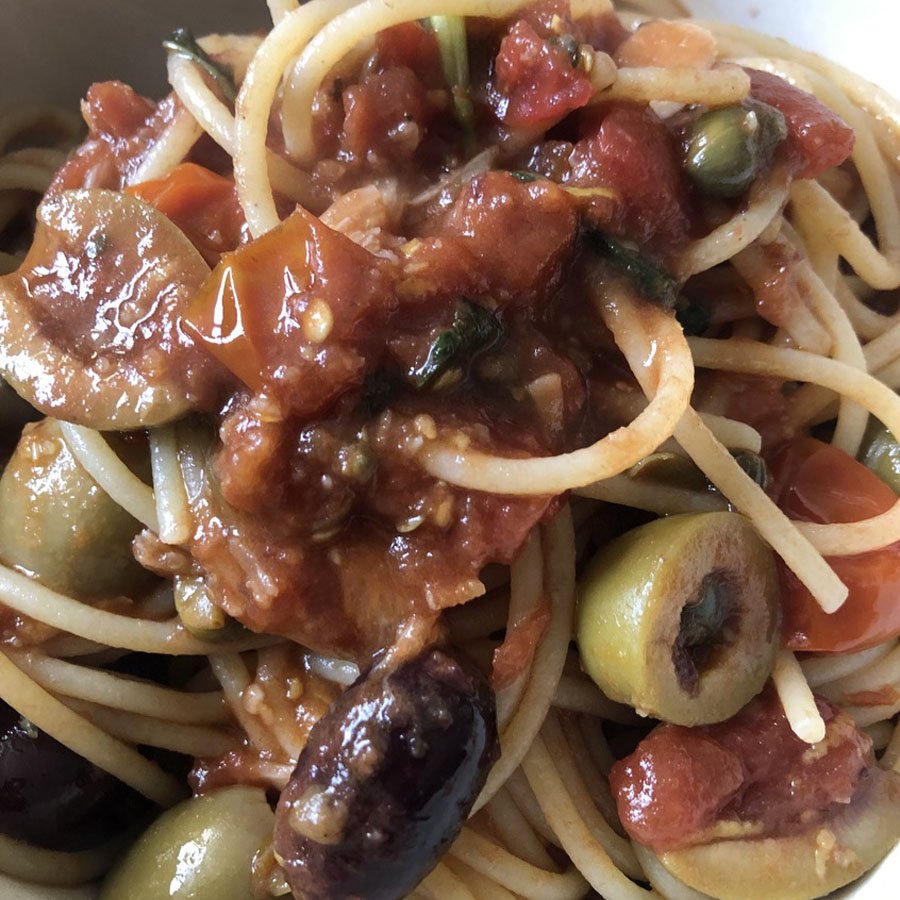Episode 3: Pasta a la Puttanesca with Imtiaz Tyab
New episodes and recipes every Friday!
“We can’t change the past,” says CBS News foreign correspondent Imtiaz Tyab who has reported on long-running conflicts all over the world. “So why don’t we start working on trying to make a better future, and if we can use food - I think that’s a pretty good gateway.”
Imtiaz knows about gateways. In this episode he shares the recipe for pasta a la puttanesca - an Italian dish packed with garlic, chili, anchovies, capers, olives, and more - because he likes bold flavors, and because “it’s really easy to make!”.
Far easier, he says, than his mom’s flavor-packed South Asian food that he grew up with, and that he couldn’t enjoy for months during the pandemic lockdown. So, weirdly, pasta a la puttanesca was Imtiaz’s gateway to learning to recreate the food of his childhood.
“I love Italian food, and Thai food, and Koren food - I am a real foodie. But there’s something about South Asian food,” he says, “that speaks to me not only in a ‘this is delicious’ kind of way but also in a ‘this is part of who I am’ kind of way.”
In return Rajesh shares his mom’s recipe for channa dhal, where the earthiness of the dhal is turbocharged with a vibrant masala, packed with green chili, cumin seeds, ginger and garlic and more.
Find and enjoy both recipes on this page.
Food is an expression of our shared humanity, and everyone has a food story to tell. What’s yours? Get in touch at rajesh@findingourflavor.com. And if you try out any of these recipes, email and let us know how they turned out - if you send us a voice note, we might use it in a future episode!
Episode 3 Recipes
Imtiaz Tyab’s Pasta a la Puttanesca
Ingredients:
5-7 anchovies in virgin olive oil, plus 3-4 tbsp of the anchovy oil (Rajesh used twice the number of anchovy filets)
4 cloves garlic, sliced
1-2 whole chillies (green or red; don’t chop, but pierce a few times to release their heat)
12-15 black olives: chop half of them, leave the other half whole
12-15 green olives: chop half of them, leave the other half whole
2 tbsp capers in brine (if only salted capers are available, rinse thoroughly)
8 cherry tomatoes, halved
14oz/400g of tinned tomatoes (diced or whole plum)
½ glass dry white wine (optional) (Rajesh used half a cup - which may have been a little generous!)
1 bunch of basil leaves, roughly chopped (about two loosely packed tablespoons)
½ lemon, zested finely
1tbsp balsamic vinegar
Salt and pepper to taste (Rajesh found he didn’t need any)
Method
Put the oil reserved from the anchovies in a large pan and place over a medium heat. Once hot, stir in the garlic and chili, and fry in the oil for a minute. Don’t have the heat too high or it’ll burn. You want the garlic to soften and melt, and the chili to start releasing its heat (if you don’t have enough oil from the anchovies add some olive oil).’
Add the olives, capers, cherry tomatoes, and anchovies (Imtiaz adds anchovies whole but you can chop them if preferred).
After anchovies start to break down, add white wine, if using, stir well and leave to cook.
After 5–6 minutes, stir in the tinned tomatoes and bring to the boil. Lower the heat and simmer for approximately 10 minutes or longer to desired sauce thickness.
Taste the sauce to check the seasoning, then stir in the balsamic vinegar, and salt and pepper if using.
Meanwhile, cook pasta according to packet instructions. Once cooked, drain, reserving a ladleful or two of the pasta water.
Add the pasta water as needed to the sauce to loosen it slightly, then stir in the lemon zest, and basil. Let it all simmer until it reduces a bit more.
It’s now ready. Traditionally the pasta is added to the sauce and tossed, then dished up.
Rajesh’s Mom’s Channa Dhal
This dish offers a wonderful contrast. The dhal retains its shape without becoming mushy, and its natural earthy flavor is perfectly embraced by the spicy, sweet tomato/onion/ginger masala. (For those who don’t like to see their onions, you could liquidize the masala before adding it to the cooking dhal). Quantities below make plenty for two people.
Ingredients
8 oz/225g dry channa dhal (available from South Asian grocery stores).
1 – 1½ inch piece of ginger, peeled, and grated or chopped,
1 green chili, deseeded and chopped
1 small onion, finely chopped.
3-4 tbsp vegetable oil.
1 level tsp black cumin seeds.
½ tsp turmeric
¾ tsp salt
⅓ can chopped tomatoes.
Water for cooking.
Method
Put the dhal in a bowl and cover with plenty of water and soak for at least two hours and up to overnight. The dhal will expand to around twice its size. Next day, drain the dhal – there’s no need to wash it.
Put the drained dhal into a large pan, add 1 pint of water (this is a UK pint which is a little larger than a US pint), or enough so that the water covers the dhal by a depth of two fingers (this is actually how my mom measures!).
Bring to the boil, and once boiling, scoop off and discard any foam that forms on the surface.
Then reduce the heat to a gentle boil, partly cover the pan and leave to cook.
While the dhal is cooking, prepare the masala: In another pan, heat the vegetable oil on low-medium.
When hot, add the cumin seeds and fry for a few seconds till they start to pop and release their aroma, but before they darken noticeably.
Add the chili and ginger, fry for a few seconds, and before they start to color, add the chopped onion.
Fry for a few minutes to soften the onion, but watch the cumin seeds also – if they start to blacken, turn down the heat (the trick here is not to wait too long before adding the onion).
Add half a can of chopped tomatoes, bring back to a boil, and then add the turmeric.
Mix, cover, and leave to cook over the same heat.
After a few minutes, the tomato/onion mixture should not look dry but there should be no obvious water left in the pan. Tilting the pan reveals the oil which should have taken on an orange tint. At this point the masala is done, so turn off the heat, leave and cover, until ready to add to the dhal.
After about 30 minutes of cooking the dhal, most of the water should have evaporated or been absorbed, and the dhal should be almost cooked. Test it by squeezing a grain between two fingers. It should not disintegrate in your fingers (as pictured above) but under pressure, you should feel some resistance before the grain splits.
At this point, add all the tomato masala, another ½ pint more water, and the salt. Mix, bring back to the boil and leave on a robust simmer, half-covered.
Check after 15 minutes for your desired consistency. Note: once you turn off the heat and leave the dhal to stand for a few minutes, it will start re-absorbing water, so make sure not to cook it too dry in the first place.










